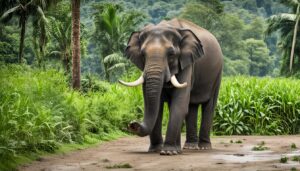Sumatran Elephant Guardians of the Rainforest
The Sumatran elephant, a majestic and intelligent creature, roams the lush rainforests of Sumatra, Indonesia. These elephants are a subspecies of the Asian elephant, recognized by their smaller size, lighter skin, and distinctive features. Despite their grandeur, Sumatran elephants are critically endangered, facing numerous threats that jeopardize their survival.

What Makes the Sumatran Elephant Unique?
Sumatran elephants are slightly smaller than their Asian counterparts, standing at around 8 to 10 feet tall and weighing up to 5,000 kilograms. Their smaller stature allows them to navigate the dense undergrowth of their forest habitats with ease. These elephants have rounded ears, a long trunk, and are known for their incredible intelligence and memory.
Their social structure is matriarchal, with groups typically led by the oldest female. These herds are close-knit, and the elephants exhibit complex social behaviors, communicating through low-frequency rumbles and even infrasonic sounds that can travel long distances through the dense jungle.
The Role of Sumatran Elephants in the Ecosystem
Sumatran elephants are keystone species, playing a crucial role in maintaining the health of their ecosystem. They are often referred to as “gardeners of the forest” because their diet consists of a wide variety of plants, including fruits, leaves, and bark. As they move through the forest, they help disperse seeds through their dung, promoting the growth of diverse plant species. This seed dispersal is vital for the regeneration of the rainforest, supporting a multitude of other species.
In addition, their large size creates natural pathways in the forest, which benefits other smaller animals by providing them access to new areas for feeding and nesting.
Threats to the Sumatran Elephant
Despite their importance, Sumatran elephants are facing a dire situation. Deforestation, driven by illegal logging and the expansion of palm oil plantations, is one of the biggest threats to their survival. As their habitat is destroyed, elephants are forced into smaller, fragmented areas, leading to increased human-elephant conflicts. In search of food, elephants often wander into plantations and villages, where they are sometimes killed or captured.
Poaching is another significant threat. Elephants are hunted for their ivory, despite a global ban on the trade. This illegal activity not only reduces their numbers but also disrupts the social structure of their herds, as poachers often target the largest and most mature elephants.
Conservation Efforts
Thankfully, there are ongoing efforts to protect the Sumatran elephant. Conservation organizations are working tirelessly to preserve their habitats, reduce human-elephant conflicts, and combat poaching. Initiatives include the establishment of protected areas, the promotion of sustainable agriculture practices, and community education programs to raise awareness about the importance of these magnificent animals.
Ecotourism is also playing a role in conservation. By promoting responsible tourism that focuses on observing and appreciating wildlife in their natural habitats, local communities can benefit economically while contributing to the protection of the elephants and their environment.
How You Can Help
You can make a difference in the survival of the Sumatran elephant. Supporting conservation organizations, choosing products that are certified as sustainable (such as palm oil-free items), and spreading awareness about the plight of these elephants are all ways you can contribute. Every small action helps ensure that these gentle giants continue to thrive in the forests of Sumatra for generations to come.
In conclusion, the Sumatran elephant is not just a symbol of Indonesia’s rich biodiversity but also a vital component of its rainforest ecosystem. Protecting these elephants means preserving the intricate balance of nature and ensuring that future generations can witness the awe-inspiring presence of these remarkable creatures.